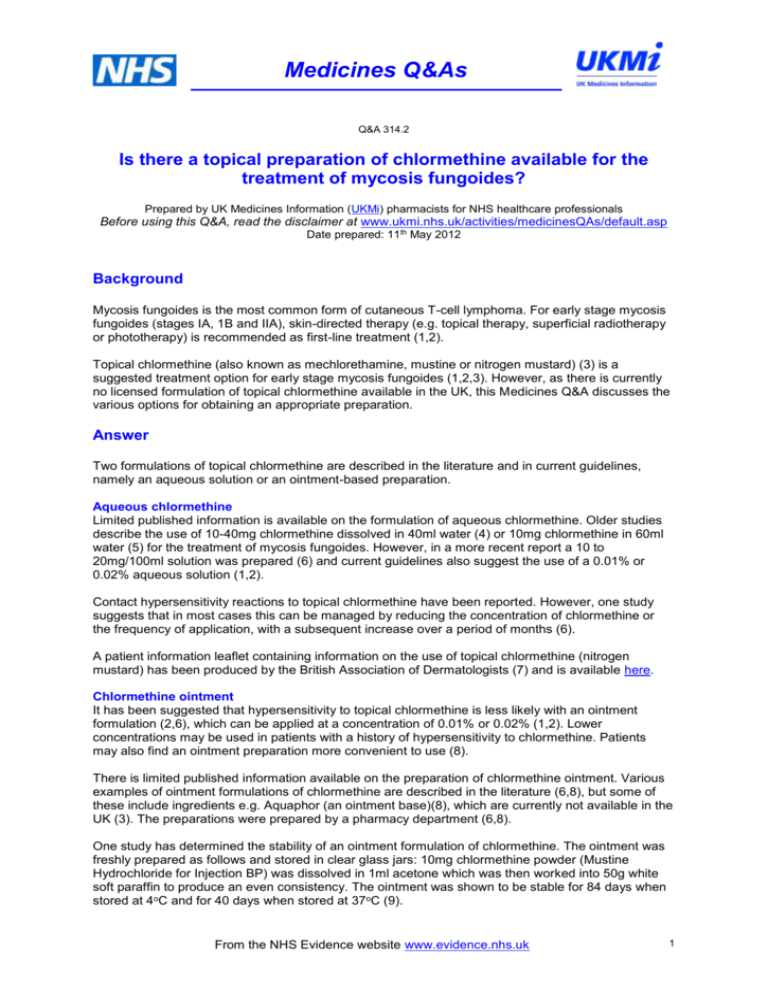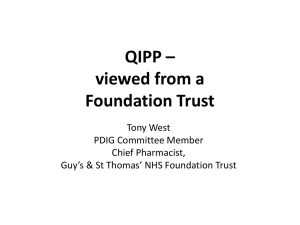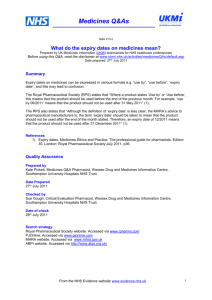UKMi Q&A xx - NHS Evidence Search
advertisement

Medicines Q&As Q&A 314.2 Is there a topical preparation of chlormethine available for the treatment of mycosis fungoides? Prepared by UK Medicines Information (UKMi) pharmacists for NHS healthcare professionals Before using this Q&A, read the disclaimer at www.ukmi.nhs.uk/activities/medicinesQAs/default.asp Date prepared: 11th May 2012 Background Mycosis fungoides is the most common form of cutaneous T-cell lymphoma. For early stage mycosis fungoides (stages IA, 1B and IIA), skin-directed therapy (e.g. topical therapy, superficial radiotherapy or phototherapy) is recommended as first-line treatment (1,2). Topical chlormethine (also known as mechlorethamine, mustine or nitrogen mustard) (3) is a suggested treatment option for early stage mycosis fungoides (1,2,3). However, as there is currently no licensed formulation of topical chlormethine available in the UK, this Medicines Q&A discusses the various options for obtaining an appropriate preparation. Answer Two formulations of topical chlormethine are described in the literature and in current guidelines, namely an aqueous solution or an ointment-based preparation. Aqueous chlormethine Limited published information is available on the formulation of aqueous chlormethine. Older studies describe the use of 10-40mg chlormethine dissolved in 40ml water (4) or 10mg chlormethine in 60ml water (5) for the treatment of mycosis fungoides. However, in a more recent report a 10 to 20mg/100ml solution was prepared (6) and current guidelines also suggest the use of a 0.01% or 0.02% aqueous solution (1,2). Contact hypersensitivity reactions to topical chlormethine have been reported. However, one study suggests that in most cases this can be managed by reducing the concentration of chlormethine or the frequency of application, with a subsequent increase over a period of months (6). A patient information leaflet containing information on the use of topical chlormethine (nitrogen mustard) has been produced by the British Association of Dermatologists (7) and is available here. Chlormethine ointment It has been suggested that hypersensitivity to topical chlormethine is less likely with an ointment formulation (2,6), which can be applied at a concentration of 0.01% or 0.02% (1,2). Lower concentrations may be used in patients with a history of hypersensitivity to chlormethine. Patients may also find an ointment preparation more convenient to use (8). There is limited published information available on the preparation of chlormethine ointment. Various examples of ointment formulations of chlormethine are described in the literature (6,8), but some of these include ingredients e.g. Aquaphor (an ointment base)(8), which are currently not available in the UK (3). The preparations were prepared by a pharmacy department (6,8). One study has determined the stability of an ointment formulation of chlormethine. The ointment was freshly prepared as follows and stored in clear glass jars: 10mg chlormethine powder (Mustine Hydrochloride for Injection BP) was dissolved in 1ml acetone which was then worked into 50g white soft paraffin to produce an even consistency. The ointment was shown to be stable for 84 days when stored at 4oC and for 40 days when stored at 37oC (9). From the NHS Evidence website www.evidence.nhs.uk 1 Medicines Q&As A stability study, published as a conference report, has calculated the shelf life of a 0.01%w/w chlormethine in 50/50 liquid paraffin/white soft paraffin ointment. On the basis of the findings of this study, shelf lives of 217 days when stored at 25oC/60% relative humidity or 218 days when stored at 7oC were allocated. The only physical change noted was an oily layer that dispersed with mixing, which appeared at 25oC/60% relative humidity (10). Availability of topical chlormethine There is no licensed formulation of topical chlormethine available in the UK. A solution for dermal application of chlormethine (Caryolysine®) which was licensed in France has recently been discontinued (11,12). A chlormethine (mechlorethamine) gel formulation has been granted Orphan Drug Status in the US and a New Drug Application was submitted to the US Food and Drug Administration (FDA) for the treatment of early stage (stages I-IIA) mycosis fungoides in July 2011 (13). However, a US product has not yet been marketed (11). The European Medicines Agency (EMA) Committee for Orphan Medicinal Products (COMP) is currently reviewing chlormethine for the treatment of cutaneous T-cell lymphoma. A positive opinion was adopted by the COMP recommending orphan designation to the European Commission in January 2012 (14). However, orphan designation has not yet been granted (14). At the time of writing, no topical or any other formulations of chlormethine could be sourced (11,12,15,16). There is currently a global supply problem with mechlorethamine (chlormethine) hydrochloride for injection (Mustargen®) (17), which has been used to prepare chlormethine ointment (8). The product is not expected to be available again until late 2012. As Mustargen ® is not licensed in the UK it would be available on a named-patient basis via a pharmaceutical importer (17). Summary Topical chlormethine (also known as mechlorethamine, mustine or nitrogen mustard) (3) is a suggested first-line treatment option for early stage mycosis fungoides (1,2,3). There is currently no licensed formulation of topical chlormethine available in the UK. Two formulations of topical chlormethine are described in the literature and in current guidelines, namely an aqueous solution or an ointment-based preparation. However, details on the preparation of these products are limited. Guidelines suggest that a 0.01% or 0.02% aqueous solution may be used to treat mycosis fungoides (1,2). It has been suggested that hypersensitivity to topical chlormethine is less likely with an ointment formulation (2,6), which can be applied at a concentration of 0.01% or 0.02% (1,2). Ointment preparations would need to be prepared by a pharmacy department. At the time of writing, no topical or any other formulations of chlormethine could be sourced (11,12,15,16). There is currently a global supply problem with mechlorethamine (chlormethine) hydrochloride for injection (Mustargen®) (17), which has been used to prepare chlormethine ointment (8). Licence applications for topical chlormethine preparations have been submitted to the US Food and Drug Administration (FDA) and the European Medicines Agency (EMA) (13,14). Limitations Only the use of topical chlormethine for the treatment of mycosis fungoides has been considered in this Medicines Q&A. Its use for other conditions has not been addressed. Data on the clinical efficacy and safety of topical chlormethine for mycosis fungoides has not been evaluated. Details about the optimum method, timing and duration of administration have not been included. From the NHS Evidence website www.evidence.nhs.uk 2 Medicines Q&As The information on the availability of chlormethine was correct at the time of writing. However, this situation may be subject to change and alternative supply routes may be investigated to source the product, if required. The clinical staging system for cutaneous T-cell lymphoma has not been discussed. See Appendix B in reference 1 for more details. References 1. Whittaker SJ, Marsden JR, Spittle M et al. Joint British Association of Dermatologists and UK Cutaneous Lymphoma Group guidelines for the management of primary cutaneous T-cell lymphomas. Br J Dermatol 2003;149: 1095-1107. Available via http://www.bad.org.uk/site/622/default.aspx (update in progress). 2. Trautinger F, Knobler R, Willemze R et al. EORTC consensus recommendations for the treatment of mycosis fungoides/Sézary syndrome. Eur J Cancer 2006; 42:1014-1030. 3. Chlormethine hydrochloride monograph. Sweetman SC, editor. Martindale: The Complete Drug Reference. Electronic edition. London: Pharmaceutical Press. Accessed via http://www.medicinescomplete.com/ on 11th May 2012. 4. Zachariae H, Thestrup-Pedersen K, Søgaard H. Topical nitrogen mustard in early mycosis fungoides. A 12-year experience. Acta Derm Venereol 1985;65: 53-58. 5. Ramsay DL, Halperin PS, Zeleniuch-Jacquotte A. Topical mechlorethamine therapy for early stage mycosis fungoides. J Am Acad Dermatol 1988;19:684-91. 6. Kim YH, Martinez G, Varghese A et al. Topical nitrogen mustard in the management of mycosis fungoides. Update of the Stanford experience. Arch Dermatol 2003;139:165-173. 7. Patient Information Leaflet. Nitrogen mustard:a preparation to be applied to the skin. British Association of Dermatologists.Updated May 2010. Accessed via http://www.bad.org.uk/Portals/_Bad/Patient%20Information%20Leaflets%20(PILs)/Nitrogen% 20Mustard%20Update%20May%202011%20-%20lay%20reviewed%20Feb%202011.pdf on 14th May 2012. 8. Price NM, Hoppe RT, Deneau DG. Ointment-based mechlorethamine treatment for mycosis fungoides. Cancer 1983;52:2214-2219. 9. Cummings J, Maclellan A, Langdon SJ et al. The long term stability of mechlorethamine hydrochloride (nitrogen mustard) ointment measured by HPLC. J Pharm Pharmacol 1993;45: 6-9. 10. Holmes A, Jones MF, Stapleton M. A stability study of mechlorethamine hydrochloride ointment using direct HPLC measurement of mechlorethamine (abstract). J Pharm Pharmacol 2002;54;S3-S4. 11. Personal communication. Durbin PLC 28th May 2012. 12. Personal communication. Mawdsleys Unlicensed Medicines 18th May 2012. 13. Ceptaris Therapeutics Website. Accessed via http://www.ceptaris.com on 16th May 2012. 14. Personal communication. Medical Information. European Medicines Agency (EMA) 23 rd May 2012. 15. Personal communication. UL Medicines 16th May 2012. 16. Personal communication. IdisPharma 14th May 2012. 17. Personal communication. Medical Information. Lundbeck Ltd UK 29th May 2012 From the NHS Evidence website www.evidence.nhs.uk 3 Medicines Q&As Quality Assurance Prepared by Kate Pickett, Medicines Q&A Pharmacist, Wessex Drug and Medicines Information Centre, University Hospital Southampton NHS Foundation Trust. Date Prepared 11th May 2012 Checked by Sue Gough (based on the Q&A originally checked by Sandra Hicks),Critical Evaluation Pharmacist, Wessex Drug and Medicines Information Centre, University Hospital Southampton NHS Foundation Trust. Date of check 20th September 2012 Search strategy DRUGDEX System. Electronic version. Greenwood Village, Colorado: Thomson Micromedex. Accessed via http://www.thomsonhc.com/ Martindale: The Complete Drug Reference. Accessed via http://www.medicinescomplete.com/ AHFS. Accessed via http://www.medicinescomplete.com/ Electronic Medicines Compendium. Accessed via http://www.medicines.org.uk British Association of Dermatologists Website. Accessed via http://www.bad.org.uk/ BNF No 63 March 2012. Accessed via www.bnf.org EMA Website. Accessed via http://www.ema.europa.eu/ema/ MHRA Website. Accessed via http://www.mhra.gov.uk/index.htm NHS Evidence. Accessed via https://www.evidence.nhs.uk New Drugs Online. Accessed via http://www.ukmi.nhs.uk/applications/NDO/dbSearch.asp European Organisation for Research and Treatment of Cancer (EORTC) website. Accessed via http://www.eortc.org/ International Society for Cutaneous Lymphomas. Accessed via http://www.cutaneouslymphoma.org/ NICE Website. Accessed via http://www.nice.org.uk/ FDA Website. Accessed via http://www.fda.gov/default.htm Personal communication with IdisPharma via email 14th May 2012. Personal communication with Durbin PLC via email 28th May 2012. Personal communication with Pharamarama via email 15th May 2012. Personal communication with UL Medicines via email 16th May 2012. Personal communication with Mawdsleys Unlicensed Medicines via email 18th May 2012. Personal communication with the European Medicines Agency (EMA) via email 23 rd May 2012. Personal communication with Lundbeck Ltd UK via email 29th May 2012. Ceptaris Therapeutics Website. Accessed via http://www.ceptaris.com From the NHS Evidence website www.evidence.nhs.uk 4



